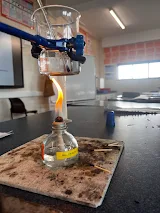Alcohols come about when a hydrogen atom in a molecule is replaced by a hydroxyl group, and from here, there's no upper limit as to how large you can go. But there is a smallest alcohol, this being methanol (methyl alcohol, or CH3OH), which is one alkyl group bonded to a hydroxy group (which looks similar to, but isn't, a hydroxide ion). There are three different ways this can come about:
- Primary alcohols have the hydroxy group at the end of the alkyl chain;
- Secondary alcohols have the hydroxy group in the midst of the alkyl chain;
- Tertiary alcohols are similar to secondary alcohols, except the hydroxy group is bonded to a carbon that also bonds with three alkyl groups.
It should also be noted that a water molecule contains a series of lone pairs, which means that alcohols are inherently polar substances. As a result, alcohols tend to form hydrogen bonds with water, which also means that many alcohols are rather soluble. Methanol and ethanol, for example, are miscible with water. The smaller the alcohol, the more soluble it is, so methanol could be used as a solvent (but isn't as it's rather toxic as a liquid); as an alcohol gets larger, the solubility decreases. Alcohols can vary by melting and boiling points too - as an alcohol increases in size, the greater amount of bonds means more energy is needed to completely break up the alcohol's bonds, so the melting and boiling points increase. I'll focus on that later.
Alcohols can be used to form various other hydrocarbons as well. Esters form from the reaction of an alcohol and carboxylic acid, and are often used in cosmetics and as solvents, whilst ketones can be formed through the oxidation of an alcohol, and are prevalent in steroid and solvent production.
Intermission on drinking alcohol
But to form alcohol for commercial purposes, there are countless reactions which produce high yields. Take the anaerobic respiration of plants and yeast, which is the main way how ethanol is obtained to create alcoholic drinks. Commonly used plants include wheat, sugarcane and corn, with large plots of land often used to maximise the amount of ethanol produced.
C6H12O6 → C2H5OH + C2O
To give an example, beer is produced as a byproduct of the anaerobic respiration which occurs in grains like wheat, and about 68 litres was consumed in the UK per capita in 2021 alone, with the beer industry worth billions in the UK. Indeed, the UK drinks more alcohol than it produces, and lots is imported from other countries. About a quarter of the global population drinks alcohol, and three million deaths each year globally are attributable to the effects of alcohol. All this is to say that ethanol is rather significant.
Intermission on using alcohol as a fuel
The process of fermentation can also be used to produce ethanol in other circumstances. Take E10 petrol; the name refers to how it contains 10% ethanol. These fuels reduce emissions of CO2 as less fossil fuels need to be burnt during combustion. Pure ethanol can also be used as a fuel, such as in Brazil where some vehicles run on E100 fuel. Countless other alcohols are also used as fuels, including methanol, which alongside being used directly in engines can also be used as an antifreeze to keep windscreen wiper fluid from freezing as it can increase the boiling point of liquids.
Chemistry Practical
Now comes the time to talk about a practical that I did which involved various alcohols. Specifically, various alcohols were burnt to heat water to calculate the overall enthalpy change. As I mentioned earlier, the energy released during this reaction ought to increase as the size of the alcohol increases - that did happen, though not to the extent that I expected.
The basic reaction was this:
CnH2n+1OH + O2 → CO2 + H2O
After calculating the mass and thus the moles of the alcohol that was burnt, it was easy to calculate how much energy was released. One thing I noticed that was peculiar was that, as only a few grams were burnt, the enthalpy changes were much smaller than the accepted values are. But I suppose there's nothing to complain about - should you burn propane for too long, inhaling it could prove dangerous.


Comments
Post a Comment